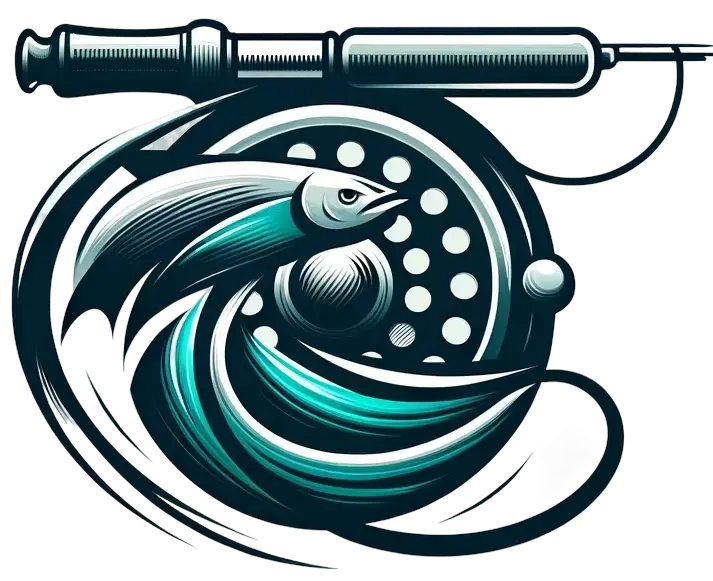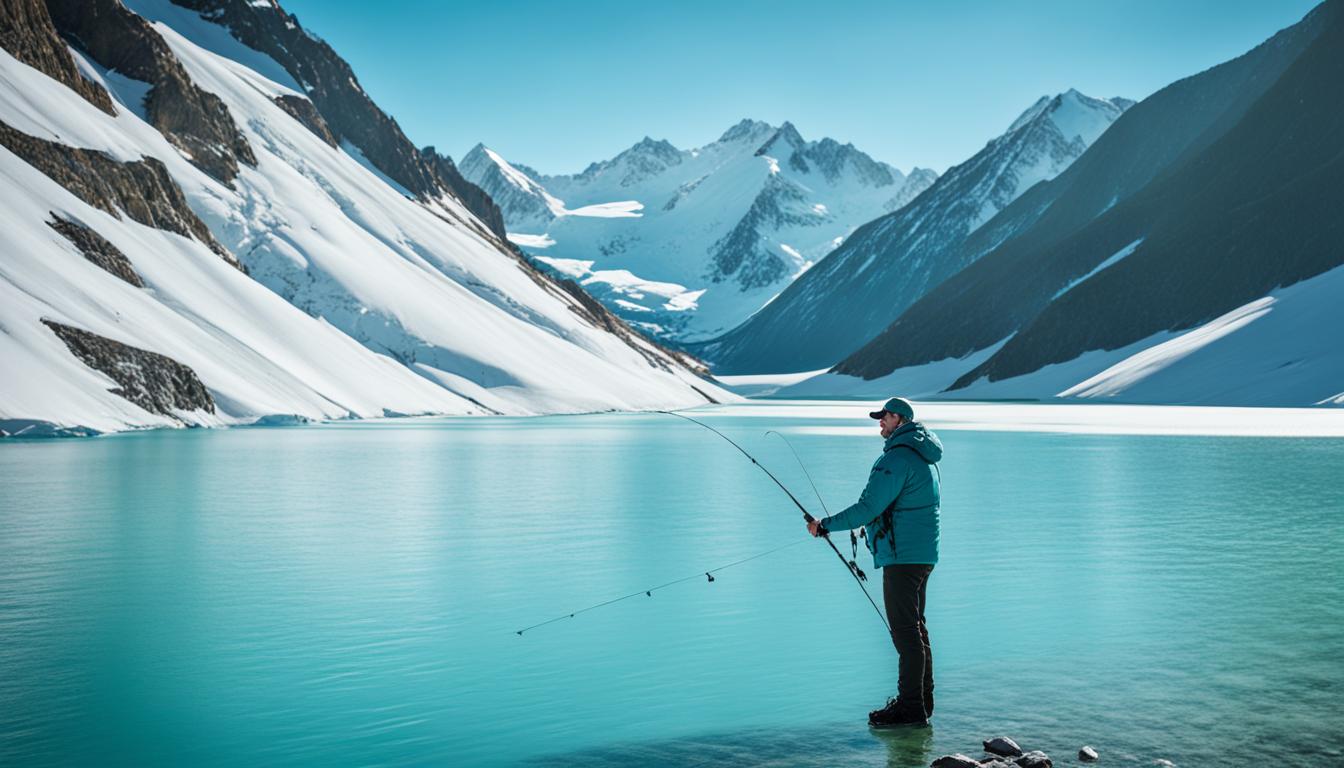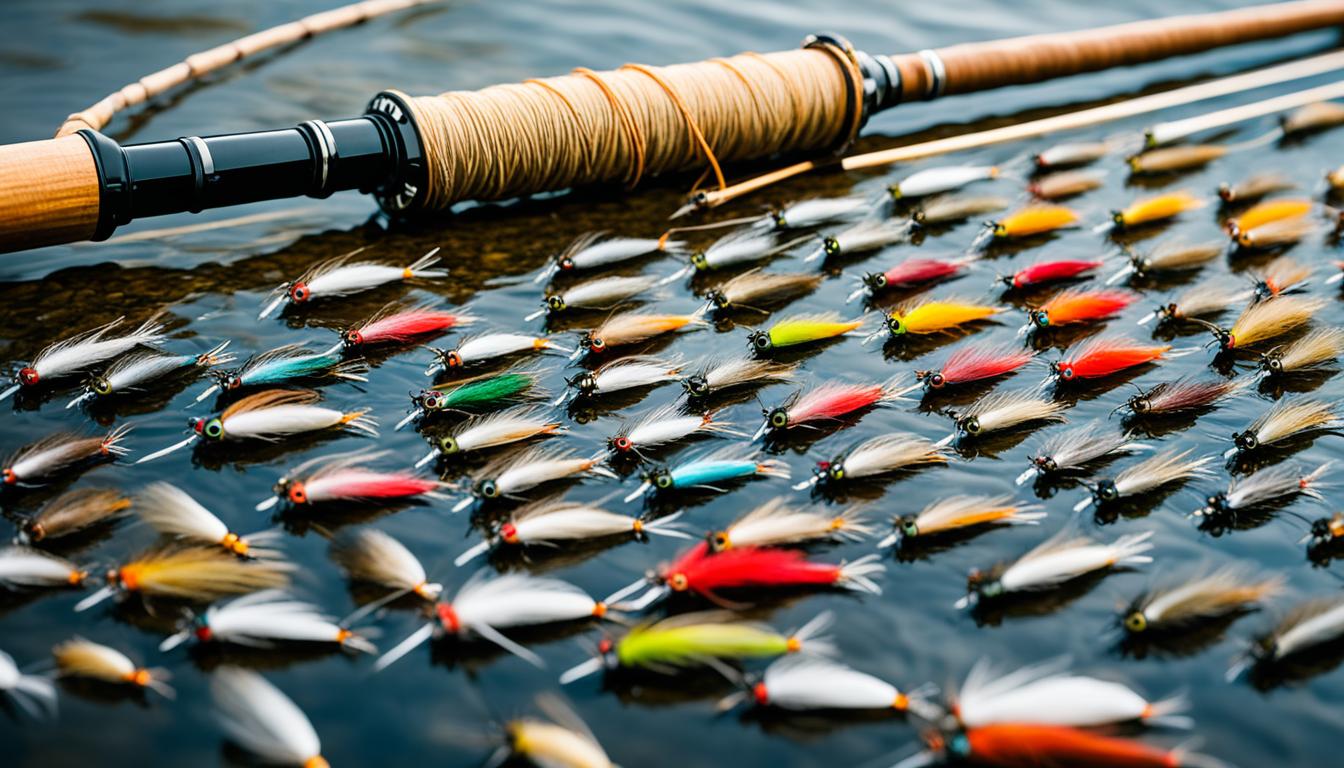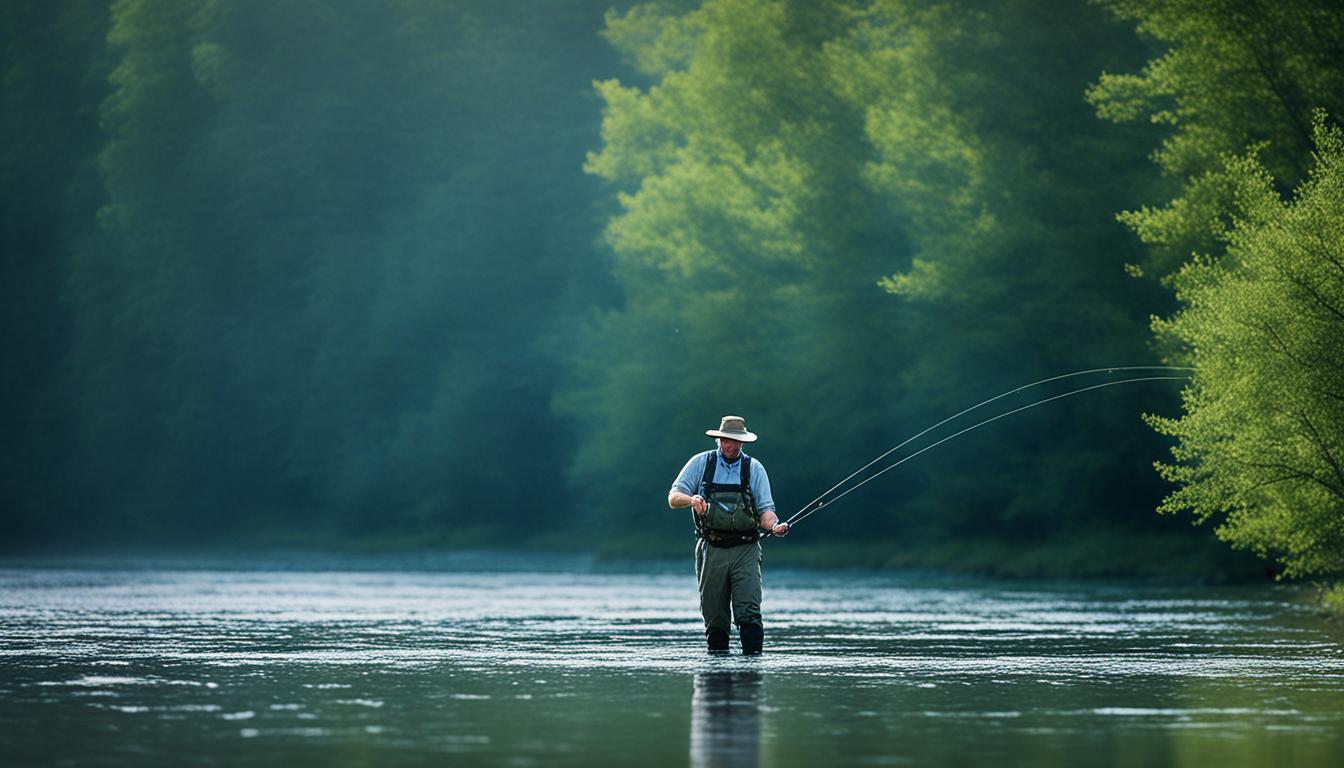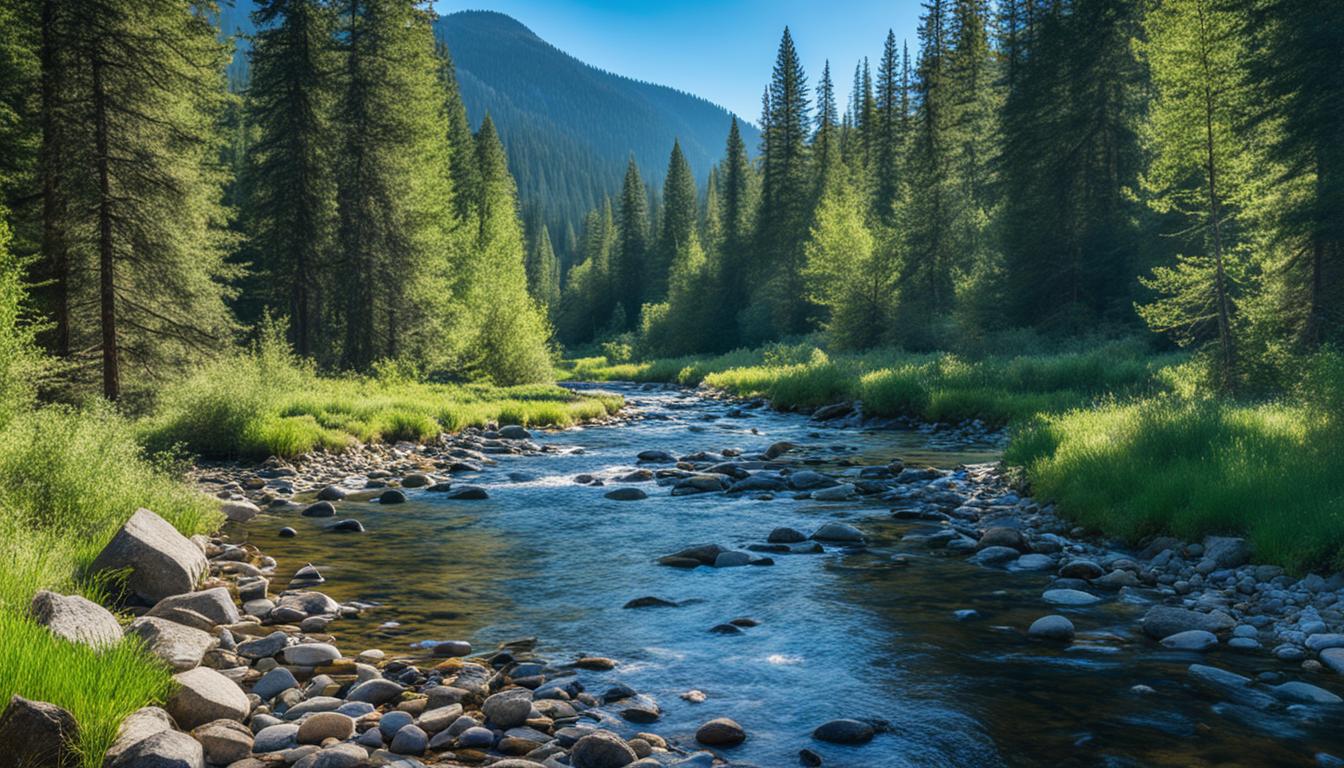Summer is around the corner, and it’s time to elevate your angling game with our expert high-altitude fly fishing techniques. Fishing in high-altitude mountain ranges requires a different approach and understanding of the unique conditions. In this article, we will share valuable tips and methods for successful high-altitude fly fishing.
Key Takeaways
- Learn elevational angling tips and mountain fly fishing methods
- Understand the nature of high-mountain trout and the different fishing locations
- Use effective techniques for catching high-mountain trout, including fly and spin fishing
- Practice stealthy approaches to avoid spooking fish in high-altitude lakes
- Explore small creeks for hidden trout gems
Understanding High-Mountain Trout and Fishing Locations
Before we delve into the high-altitude trout fishing strategies and fly fishing at higher altitudes, it’s crucial to have a solid understanding of the nature of high-mountain trout and the various fishing locations available to us. These majestic fish species, including cutthroat, golden, rainbow, brook trout, and arctic grayling, call alpine lakes and streams their home. While some of these trout species are native to specific areas, many lakes are stocked with these prized fish.
When planning our next high-altitude fly fishing adventure, taking the time to research the stocking regimes and fishing locations provided by state game agencies can greatly enhance our chances of a successful and fulfilling experience. These valuable resources can help us identify the best fishing spots, ensuring we make the most of our mountain stream fly fishing tactics. Whether we prefer the tranquility of remote alpine lakes or the thrill of casting in turbulent streams, understanding the different fishing locations is key to maximizing our time on the water.
Now that we’re equipped with this knowledge, let’s explore the effective techniques for catching high-mountain trout in the next section. But first, let’s take a moment to appreciate the beauty of this high-altitude habitat with an image of a serene alpine lake:
Effective Techniques for Catching High-Mountain Trout
When it comes to catching high-mountain trout, we have discovered several effective techniques that every angler should know. Whether you prefer the art of fly fishing or the thrill of spin fishing, there are strategies that will increase your chances of success in these alpine waters.
For fly anglers, versatility is key. Start with small dry flies like the Elk Hair Caddis or Parachute Adams. These patterns mimic the insects found near mountain streams and lakes, enticing hungry trout to strike. However, don’t hesitate to switch to larger patterns like Wooly Buggers or Zonkers if the trout are not responding to smaller flies.
Spin anglers can also find success with the right lures. Opt for small Panther Martin or Roostertail spinners that imitate smaller baitfish, which are often on the trout’s menu. Additionally, Little Cleo or Kastmaster spoons are excellent choices for covering more water and attracting aggressive trout.
If you prefer a more traditional approach, natural bait can be highly effective. Using worms, salmon eggs, or even a grasshopper can entice pickier trout. Consider using these baits behind a casting bubble for added casting distance and control.
Remember, the key to successful high-mountain trout fishing is to experiment with different techniques and adjust your approach based on the fish’s preferences for that particular day. Pay attention to their feeding patterns and adapt accordingly.
Fly Fishing Techniques
“Fly fishing for high-mountain trout requires finesse and precision. It’s all about presenting the right fly to a hungry trout and imitating their natural prey.”
To increase your chances of success, here are some additional fly fishing techniques to consider:
- Match the hatch: Observe the insects around you and choose a fly that closely resembles the bugs the trout are feeding on.
- Dead-drift presentation: This technique involves casting your fly upstream and allowing it to drift naturally with the current, mimicking an easy meal for the trout.
- Strip and pause: For streamer fishing, utilize a slow and erratic retrieve, imitating a wounded or fleeing baitfish.
Spin Fishing Techniques
“Spin fishing offers anglers the opportunity to cover more water and generate enticing action, triggering aggressive strikes from high-mountain trout.”
Consider these spin fishing techniques to enhance your chances of success:
- Vary your retrieve speed: Trout can be fickle, so experiment with different retrieval speeds, including steady, fast, or even jerking motions to match their preferences.
- Target structure: Look for underwater cover such as rocks, fallen logs, or submerged vegetation. These areas often hold trout seeking shelter and ambush points for their prey.
- Casting accuracy: Practice accurate casting to ensure your lure lands close to structures and feeding opportunities, increasing your chances of enticing a bite.
| Fly Fishing Techniques | Spin Fishing Techniques |
|---|---|
| Match the hatch | Vary your retrieve speed |
| Dead-drift presentation | Target structure |
| Strip and pause | Casting accuracy |
Stealthy Approaches for High-Altitude Fly Fishing
When it comes to high-altitude fly fishing, mastering stealthy approaches is essential. In the clear and calm waters of high-altitude lakes, fish have heightened senses and can easily detect disturbances from above. To increase your chances of success, follow these tips for a stealthy angling approach:
- Blend in with camouflage clothing: Wear clothing that matches the natural surroundings, making it harder for fish to spot your presence.
- Avoid sudden movements: Fish in high-altitude lakes are already cautious due to the presence of predators, so any rapid movements could startle them. Take your time and make slow, deliberate motions.
- Crouch while casting: Lowering your profile helps minimize your visibility to the fish. Stay low and cast with precision.
- Assess the situation: Before entering the water, observe the fish and their behavior from a safe distance. Look for cruising trout and choose your casting spots strategically.
- Position yourself on the edge: Instead of wading through the lake, position yourself on the edge where you are less likely to disturb the fish. This allows you to cast ahead of the path of cruising trout without spooking them.
- Try blind casting: In deeper or murky lakes where fish are not easily visible, blind casting with nymphs and streamers can be productive. Explore different areas of the lake and experiment with depths to find feeding fish.
By employing these stealthy angling techniques, you’ll increase your chances of fooling high-mountain trout in their natural habitat. Remember, patience and careful observation are key to success in high-altitude fly fishing.
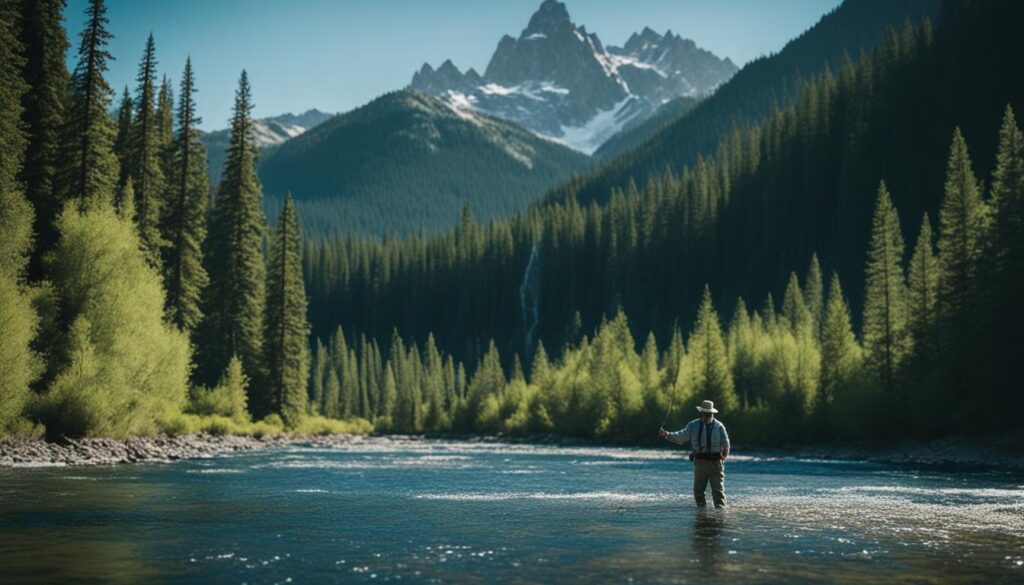
| Benefits of Stealthy Angling | Stealthy Angling Techniques |
|---|---|
| Increased chances of catching fish | Blend in with camouflage clothing |
| Minimized disturbance to fish | Avoid sudden movements |
| Opportunity to observe fish behavior | Crouch while casting |
| Strategic casting ahead of fish | Assess the situation |
| Less spooking of cruising trout | Position yourself on the edge |
| Productive in deeper or murky lakes | Try blind casting |
Exploring Small Creeks for High-Mountain Trout
While high-altitude lakes are undoubtedly captivating, it would be remiss to overlook the uncharted potential of the small creeks that flow into these majestic bodies of water. These seemingly insignificant waterways are often laden with snowmelt and overflow from the lakes, creating a haven for high-mountain trout. In fact, these hidden gems hold the potential to be trout gold mines. The auditory and visual camouflage provided by the moving water tend to attract fish, making these small creeks prime fishing spots.
In search of our next angling adventure, we urge you to explore the inflow and outflow of alpine lakes, where these small creeks meander through nature’s wonders. Their limited accessibility can deter many anglers, but those who dare to venture will be rewarded with some of the most thrilling moments an angler’s heart can experience.
Trout Riches in the Merging Tides
“Just a few casts into that unassuming creek and my line went tight! A breathtaking fight ensued as the trout put up a valiant struggle to escape my grasp. It was in that moment that I realized the true allure of these hidden treasures. The small creeks that intertwine with high-mountain lakes hold a wealth of fish waiting to be discovered by the adventurous angler.”
As the image above beautifully illustrates, these small creeks are brimming with life. Trout gather in these areas to feast on the abundance of food sources carried downstream, creating an angler’s paradise tucked away in nature’s embrace. Don’t miss the chance to cast your line into these pristine waters and indulge in the thrill that awaits.
The Makings of an Ideal Hideout
But what exactly makes these small creek inlets and outlets so attractive to trout? The answer lies in the perfect combination of factors that create an ideal hideout for these majestic fish. The visual and auditory cover provided by the flowing water provides a sense of security, allowing trout to freely explore their surroundings without alerting potential predators. Furthermore, the abundance of food sources that gather at these merging tides makes it an irresistible feeding ground for trout of all sizes.
| Advantages of Fishing Small Creeks for Trout |
|---|
| 1. Visual and auditory camouflage for trout in flowing water |
| 2. Abundance of food sources carried downstream |
| 3. Lesser angler foot traffic, providing a more secluded experience |
| 4. Higher chances of encountering larger fish seeking refuge in these hidden spots |
Due to the limited accessibility and often overshadowed popularity of these small creeks, you’ll find yourself immersed in nature’s serenity, away from the crowds. This seclusion not only heightens the experience but also increases your chances of encountering larger trout seeking refuge in these hidden spots. Be prepared to land your next trophy catch!
So, whether you’re an experienced angler or just beginning your high-altitude fly fishing journey, let your curiosity lead you to these small creeks. Explore the mesmerizing merger of water and wilderness, embark on an angling adventure like no other, and uncover the tranquil beauty that awaits.
Understanding the Water Column and Adjusting Techniques
Understanding the water column is crucial for maximizing your success in high-altitude fly fishing. Fish behavior changes with the changing seasons, and being able to adapt your techniques accordingly can greatly increase your chances of landing a catch. Let’s explore how to effectively fish the water column and adjust your fly fishing techniques.
In early spring, as the ice melts off the fringes of the lakes, fish become more active and are more likely to be found in shallow waters. They are eager to feed after the long winter months, making this an excellent time to target them in the top layers of the water column. Focus on presenting your flies or lures near the surface, enticing the trout with small dry flies or nymphs that resemble emerging insects.
As summer progresses and temperatures rise, fish may seek colder and deeper waters in the middle of the lake. They are more cautious and may be less inclined to rise to the surface for a meal. To increase your chances of success, try adding more weight to your fly line or using sinking lines to reach the desired depths. Targeting deeper waters with nymphs, weighted streamers, or larger wet flies can yield positive results.
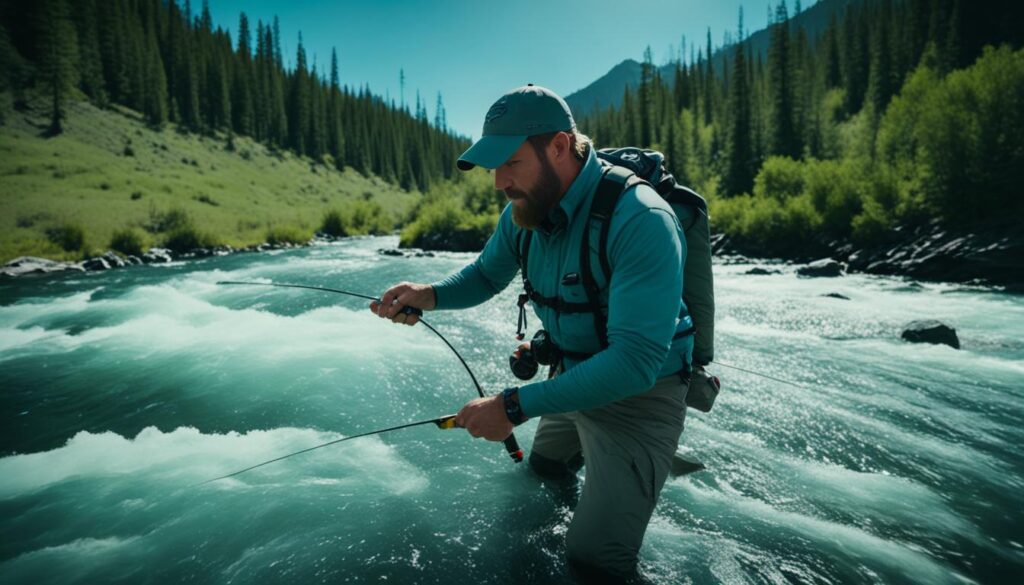
It’s important to pay attention to fish behavior and adapt your fishing methods accordingly. If you’re not seeing any action in a particular depth range, don’t be afraid to experiment and try different techniques. By understanding the water column and adjusting your fly fishing techniques, you can effectively target fish at various depths and increase your chances of success.
Conclusion
High-altitude fly fishing offers a unique and rewarding experience in breathtaking landscapes. Our article has provided you with a comprehensive guide to mastering high-altitude fly fishing techniques. By understanding the nature of high-mountain trout, utilizing effective techniques, being stealthy, exploring small creeks, and adjusting your approach based on the water column, you can elevate your angling game and improve your chances of success.
Remember, when engaging in high-altitude fly fishing, it is crucial to practice conservation and be mindful of the fragile alpine ecosystems. By respecting the environment and its inhabitants, we can ensure that these pristine fishing destinations are preserved for future generations.
Whether you are a novice angler or a seasoned fly fisher, we encourage you to put these high-altitude fly fishing techniques to the test. The combination of breathtaking landscapes, challenging conditions, and the thrill of catching high-mountain trout creates an unparalleled angling experience. So grab your gear, find your next alpine fishing spot, and get ready to elevate your angling game!
FAQ
What are some effective techniques for catching high-mountain trout?
Fly anglers can use small dry flies, nymphs, and streamers, such as Elk Hair Caddis, Parachute Adams, Wooly Buggers, or Zonkers. Spin anglers can try small Panther Martin or Roostertail spinners, and Little Cleo or Kastmaster spoons. Natural bait or flies behind a casting bubble can also be successful. Experiment with different techniques to find what works on any given day.
How can I be stealthy while fly fishing in high-altitude lakes?
To be stealthy, wear camouflage clothing and avoid rapid movements that could spook the fish. Crouch while casting and assess the situation from a safe distance before entering the water. Position yourself on the edge of the lake and patiently wait for cruising trout, casting ahead of their path to avoid spooking them. Blind casting with nymphs and streamers can also be productive in deeper or murky lakes.
Are small creeks worth exploring for high-mountain trout?
Yes, small creeks that flow into high-altitude lakes can be trout gold mines. These creeks often carry snowmelt and overflow from the lakes, attracting fish. Fish tend to concentrate in these areas due to the auditory and visual camouflage provided by the moving water. Explore the inflow and outflow of alpine lakes to find hidden gems and prime feeding areas for trout.
How should I adjust my techniques based on the water column?
It’s important to understand the water column to be successful. In early spring, fish will be shallow and aggressive as the ice melts off the fringes of the lakes. Later in the summer, they may seek colder and deeper water in the middle of the lake. Adapt your techniques accordingly and be able to pursue the fish at different depths. Start by fishing what’s in front of you, but if you’re not seeing any action, add more weight and target deeper waters. Pay attention to fish behavior and adjust accordingly.
